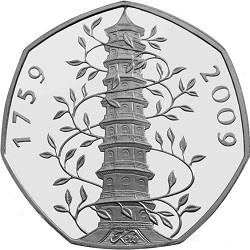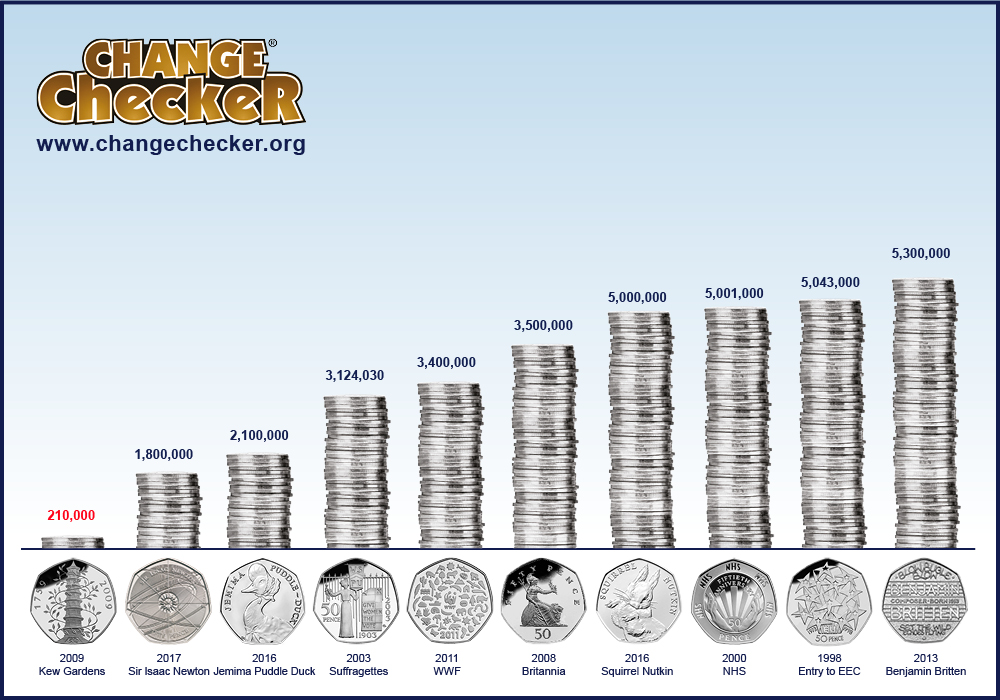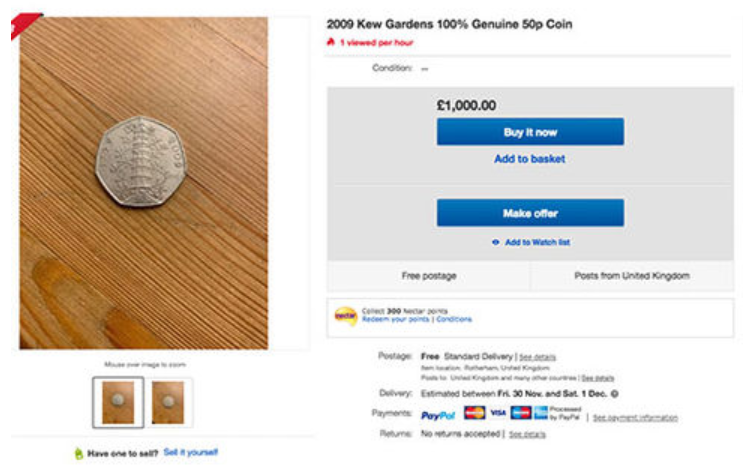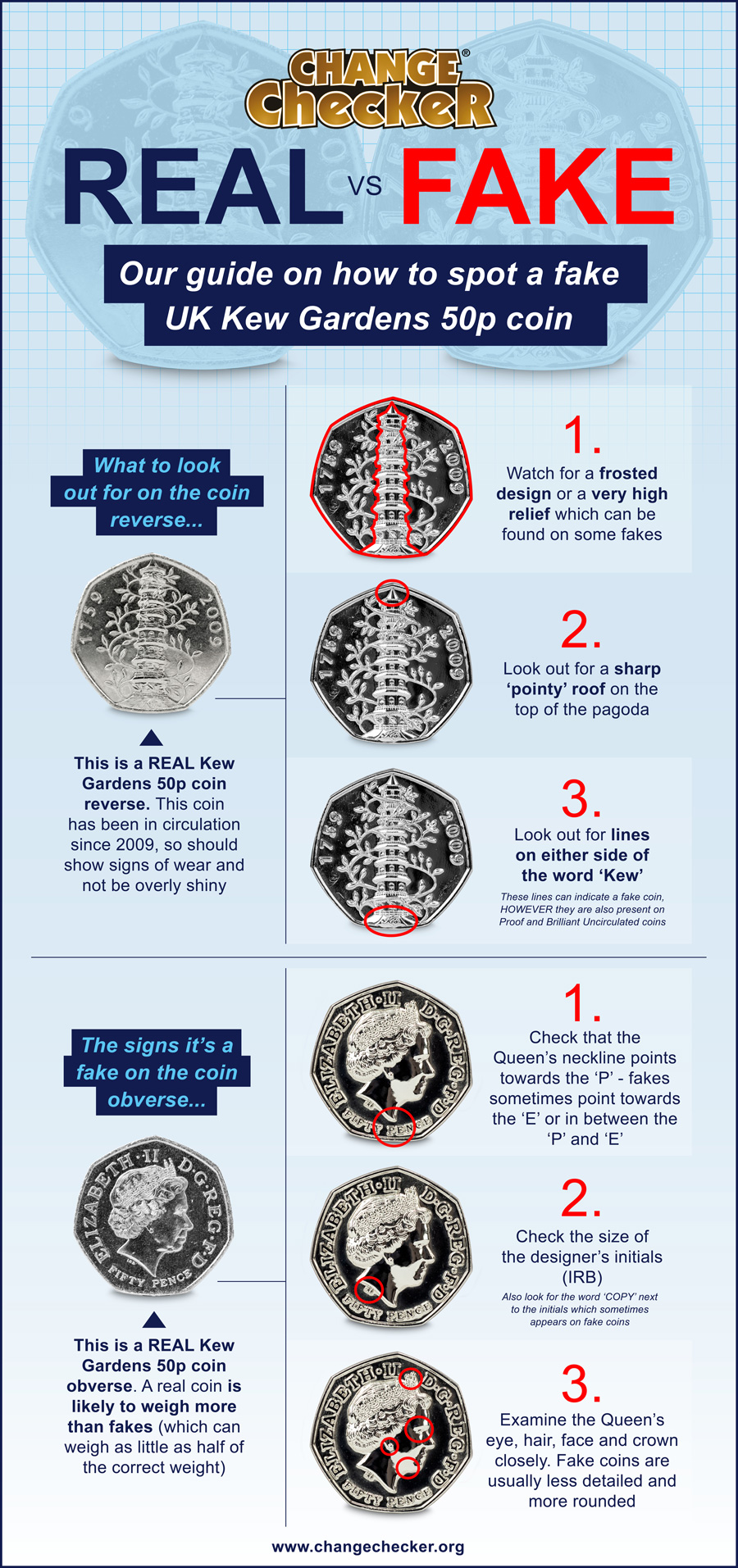Posts Tagged ‘Kew’
So you think you know the Kew Gardens 50p?
The rarest 50p in circulation, the 2009 Kew Gardens 50p, is at the top of many collectors’ wish lists, but how well do you actually know this elusive coin?

Extremely low circulating mintage
Most collectors will know that what makes the Kew Gardens 50p so sought-after is its incredibly low mintage figure of just 210,000! That’s nearly 7 times less than the next rarest circulating 50p – the 2018 Peter Rabbit 50p.
With 1.5 billions 50ps in circulation since 1997, that means Kew Gardens 50ps make up just 0.013% of all circulating 50ps!

A question we were asked recently is ‘Why were so few Kew Gardens 50ps put out into circulation?‘
The answer is simple – demand for the 50p denomination was not high at the time when the Kew Gardens 50p was released into circulation. But why…
Banks, cash centres and the Treasury forecasted demand for coin denominations and had put their order in with The Royal Mint for 2009 coins. The Royal Mint started minting the Kew Gardens 50ps, but as the forecast was reduced, minting had to be stopped after just 210,000 had been produced. So the 210,000 2009 Kew Gardens 50ps we have in circulation today were originally just the start of a much bigger order.
Another factor which could have contributed to the forecast being reduced is the huge amount of 50ps which went into circulation the year before – a whopping 26,247,000!
How to spot a fake
Unfortunately, this level of attention and popularity can cause problems, and some unlucky collectors fell pray to buying fake Kew Gardens 50ps on the secondary market.
Luckily, there are some easy ways to identify an authentic Kew Gardens 50p, here’s what to look out for which could indicate a fake:
- Frosted finish on the pagoda and years
- High relief design
- An extra pointy roof on the pagoda
- The Queen’s neckline alignment
- Larger designer initials
- More rounded features on Queen Elizabeth II’s portrait
- Lighter than a standard 50p (8 grams)

Design difference
It’s often thought that two extra lines either side of the word ‘Kew’ at the bottom of the design is another sign of a fake Kew Gardens 50p, and whilst this can indicate a dodgy copy, these lines do actually appear on the Brilliant Uncirculated and Proof versions of the coin.

Image credit: The Royal Mint
This is likely due to the level of detail achieved by striking proof and brilliant uncirculated coins making the lines more visible than on the circulating version.
The Kew Gardens 50p was re-issued in 2019 as part of the 50th Anniversary of the 50p celebrations, however this version was not intended for circulation and therefore also features the extra lines.

Did you know, coins intended for circulation are struck just once at a rate of up to 750 per minute, whereas Brilliant Uncirculated coins are struck twice with a greater force using hand polished dies at a rate of up to 300 per minute, giving much more definition. Proof coins go the extra step and are struck several times at a rate of between 50 and 100 per hour.
Potential Errors
Minting errors and mis-strikes can make coins more sought after by collectors and even add value. A few eagle eyed collectors have reported finding interesting variations on their Kew Gardens 50ps which could be a result of an error or mis-strike at the time of minting.
Extra ‘leaf’
One collector took to an online coin forum to share their Kew Gardens 50p which had what looked like an additional leaf at the bottom right of the pagoda. After some speculation, it was suggested that the extra ‘leaf’ may have been caused by die wear or maybe a die chip during striking.

Image Credit: MrV via coincommunity.com
‘Struck thru’
A strike-through, or ‘struck thru’ error is caused by another object coming between a blank and a die at the time of striking. The outline of the object – usually staples, metal shavings, cloth fibres or hairs – is pressed into the blank’s surface.
A handful of collectors reported finding strike-through errors on the obverse of their Kew Gardens 50p, one across the Queen’s cheek, the other at the top left of the obverse. Both of these have been authenticated by the Numismatic Guaranty Company as genuine errors.

Image Credit: JackCoins1975 via eBay

Credit: Mr Jibble on YouTube
Do you have a Kew Gardens 50p?
Are you one of the lucky 210,000 people to own a 2009 Kew Gardens 50p? Or perhaps you got your hands on a 2019 re-issue? Let us know in the comments!
Real, Fake and Re-issued… The inside story on the Kew Gardens 50p!
In the world of coin collecting, there’s one 50p in particular which is prized above all others. The one coin collectors strive to add to their collections… The Kew Gardens 50p.
We’ve taken a look at the inside story of this famed 50p to give you all the details you need to know about the coin – real, fake and re-issued…
Celebrating the 250th anniversary of the Royal Botanic Gardens at Kew

Released by The Royal Mint in 2009 to celebrate the 250th anniversary of the Royal Botanic Gardens at Kew, the striking design by Christopher Le Brun RA features the famous Chinese Pagoda at Kew entwined by a decorative leafy climber. It’s an image I’m sure many Change Checkers are familiar with, but not every Change Checker has been lucky enough to find one, and that’s because the mintage figures for this coin are so low…
The scarcest UK coin in circulation
In 2014, The Royal Mint revealed that only 210,000 Kew Gardens 50p coins had been struck, making it the scarcest UK coin in circulation.
Until this point, the coin had been somewhat overlooked, but once collectors realised just how rare this coin really was, the race was on to find one in their change – a challenge which to this day has coin collectors hunting far and wide for the chance to find one.
It’s estimated that just 1 in 300 people are likely to come across the Kew Gardens. When you compare its scarcity to the average 5 million coins per design usually issued into circulation, you start to really understand just how rare this coin is.

Whilst we don’t know for sure why so few coins were struck, we do know that The Royal Mint strikes new coins to meet the demand from cash centres, banks, Post Offices and distribution centres and perhaps demand was low that year. This might also have been in preparation for the 29 50p designs that would be released a few years later for the London Olympics.
It’s important to mention that there were also 128,364 Brilliant Uncirculated Kew Gardens 50p coins minted, meaning the rarity of the Kew Gardens design lies in its circulating form, rather than with the uncirculated coins.
Selling for over 200 times face value
Those that have come across the Kew Gardens 50p have the opportunity to make a tasty profit on the 50p, with our eBay Tracker figures showing the average sold price for the coin at £138, with some in good condition still selling for even more!
Bidders have driven phenomenal prices for the Kew Gardens 50p on eBay, which continues to sell at over 200 times face value. However, there are chancers out there that have been seen to list the coin for eye watering amounts in the thousands! As our blog debunking eBay coin prices explains, whilst a coin might be listed for a high price, it is actually unlikely to have sold for this price. However, high priced coins on eBay often draw attention from press articles, which further feeds into the hype surrounding the coin.

Beware of fakers
Unfortunately for collectors, fake Kew Gardens 50p coins are out there and to the untrained eye they can be tricky to spot… Take a look at the infographic below to find out what you should be looking for to spot a fake Kew Gardens 50p:

You can also check out our video guide on how to spot a fake Kew Gardens 50p here:
Re-issued Kew Gardens 50p
Towards the end of 2018, The Royal Mint announced that the coin would be re-issued in 2019 as part of the 50th anniversary of the 50p coin set and unsurprisingly when these coins became available they were snapped up by collectors in a matter of mere hours!
The set was made available in base Proof, Silver Proof and Gold Proof specifications, at a very limited number. In fact, the full range of 3,500 base Proof sets, 1,969 of the Silver and just 75 Gold completely SOLD OUT!
Has the 2009 Kew Gardens 50p become less valuable?
Some collectors were nervous that re-issuing the Kew Gardens 50p would cause the value of the original 2009 coin to drop. We can confidently say that due to the fact the re-issued coin is dated 2019 and didn’t enter circulation, the scarcity of the original 2009 dated coin has not be affected and this continues to be the UK’s scarcest coin currently in circulation.

Have you been lucky enough to find a Kew Gardens 50p in your change? Let us know in the comments below.
Receive new UK coins without the hassle of placing orders on the day of release!
Join the Change Checker UK CERTIFIED BU Subscription Service and receive new UK coins sent to your door without the hassle of placing orders on the day of release!
Don’t miss your chance to get ahead of the crowd and be one of the very first collectors to receive the latest UK new issue coins as soon as possible after their release.

